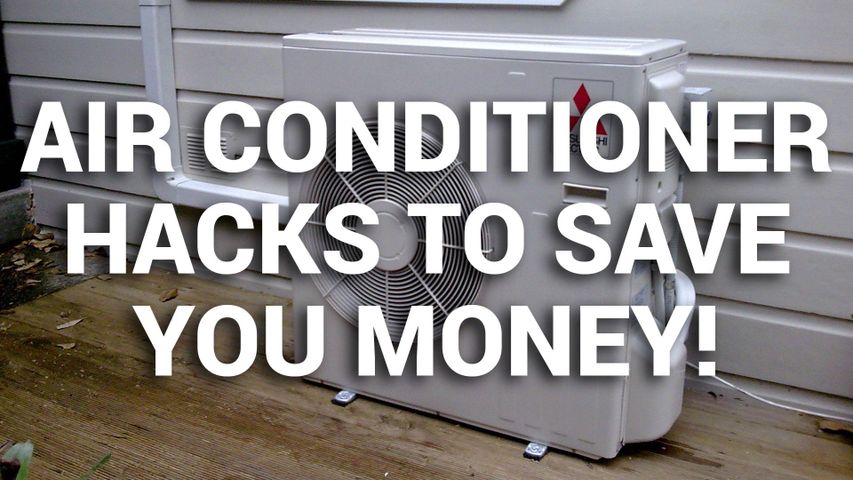Stay Cool and Save Money With Our Top 5 AC Hacks!! Click here to read more...

The hot weather is coming and with it, the need to reduce the heat and humidity inside your home. When you turn on your AC as the temperature rises, the degrees may be dropping, but your electric bill is headed in the opposite direction.
While you can’t control Mother Nature, there are some strategies you can use to save some money and still enjoy the cooler air your AC provides.
AC Hack #1: Maintain the machinery.
Whether you have window AC units or a central air system, maintain your AC equipment so that it runs most efficiently.
Start with the filter. Replacing a dirty or clogged filter with a clean one can lower your air conditioner’s energy consumption by 5-15%. How often should an AC filter be changed? Check it monthly and replace as needed, since running the AC constantly, especially in an environment that is prone to dust or contaminants, can require more frequent replacement.
For homes with a central air system, don’t forget to check the outdoor condenser coils and remove any dirt or debris that have accumulated around the unit. Aim to establish a two-foot space between the unit and any foliage. Then, repair or replace any damaged pipe insulation on the larger refrigerant line (the suction line) that brings the cool refrigerant back to the compressor in the outdoor unit. (The smaller copper line doesn’t need insulation.)
AC Hack #2: Stop the sun.
Curtains, drapes, blinds, and film are among the most popular, energy efficient window options to help block heat and save you money on cooling costs. Choose the combination that works best for your home, especially if you live in an area with both strong summer heat and winter cold. For example, tightly-installed cellular shades can reduce unwanted solar heat through windows by up to 80%, while slat-type blinds can be adjusted to control glare, light and solar heat gain.
To take it a step further, choose medium-colored draperies with white-plastic backings. These can reduce heat gains by about 33% if you close them on windows receiving direct sunlight.
If you live in a climate with long cooling seasons, consider window film, since it helps block against solar heat gain while also protecting against glare and ultraviolet exposure. For maximum benefit, use film on east- and west-facing windows because of their greater potential for heat gain.
AC Hack #3: Deter the drafts.
If you have a window AC unit, you want a secure seal between the unit and the window frame to keep the cool air inside. An improperly installed room AC can leak as much air as a six-inch square hole. With the strong seal intact, make sure the unit is level so the inside drainage system and other mechanisms operate at maximum efficiency.
Need a new window AC? Opt for one with the ENERGY STAR® label. It will use 10% less energy and cost only about $70 per year to run, on average. (Not sure what size? ENERGY STAR has a window AC size guide.)
AC Hack #4: Tweak the temperature.
There’s no need to have your AC run at your preferred coolness setting if you’re not there to enjoy it. Using a Wi-Fi thermostat gives you the ability to set the temp higher when you’re not around, and then adjust it when you’re heading back home.
If you haven’t installed a smart thermostat yet, make manual adjustments that keep the temperature higher when no one is home and then lower it for comfort when you’re back in the house. Especially if you’ll be taking a summer vacation!
AC Hack #5: Reverse the rotation.
A ceiling fan can help boost the cooling impact of your AC, saving energy and money. When you use a ceiling fan with your AC unit, you can raise your thermostat setting about four degrees with no reduction in comfort, since the air movement creates a feeling of coolness. Or, to put it in watt terms, while your central air conditioning unit burns through 3,500 watts of energy when running, the average ceiling fan uses only 60 watts. Then, shut off the fan when the room is unoccupied since its function is to make you feel cooler, not actually cool the room.
If you’re buying a ceiling fan, start by choosing one with the ENERGY STAR® label. It moves air 20% more efficiently, on average, than standard models. Select the size that fits the dimensions of your room. Your ceiling should be at least eight feet high and the fan diameter should be appropriate to the square footage of the space: 36- or 44-inch diameter for a room up to 225 square feet and 52 inches or more for a larger room. For spaces longer than 18 feet, use multiple fans for better performance.
Maximize your ceiling fan’s effectiveness by ensuring the fan is directing the air down, which is counterclockwise on most models. Not feeling the breeze? Shut off the fan, find the switch or button on the base that controls the direction of the fan’s airflow and moves it to the other end. Then test it again. Just remember to change it the other way when it’s time for heat.
These AC hacks do more than keep you cool over the summer months—they’ll also help save you money and reduce your home’s environmental impact!!
ADE Heating and Cooling
609-693-6050
NJ Master HVACR Lic # 19HC00400200
NJ Master HVACR Lic # 19HC00136200
NJ Master Plumbing Lic # 36B100668500
About the Business
Have a question? Ask the experts!
Send your question

